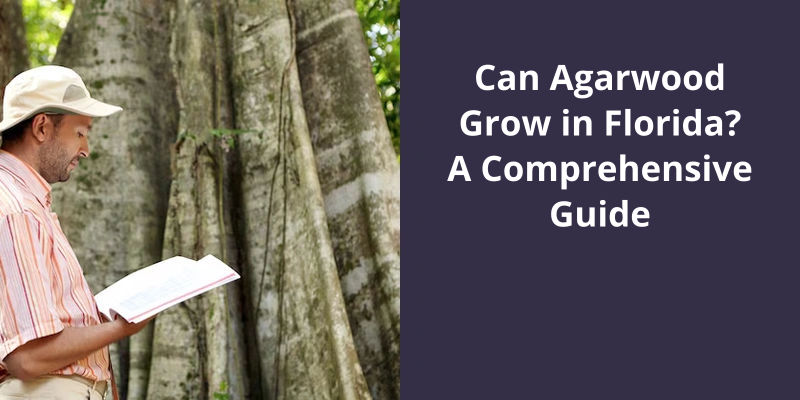Agarwood, also known as ‘oud’, can indeed be grown in Florida. This exotic plant is best suited for growth in tropical climates with high humidity, similar to Florida’s weather conditions. However, successfully growing Agarwood requires certain specific conditions and care, including suitable soil and controlled temperature levels. Additionally, a lengthy incubation period is necessary as it can take up to 20 years for the resin that is used in perfumes to form. Therefore, while Agarwood can theoretically be grown in Florida, it’s not a straightforward process and requires significant time and knowledge.

Where Is the Best Place to Plant Agarwood?
When it comes to planting agarwood, the location plays a crucial role in it’s growth and development. Agarwood is a source of high-value resinous wood that’s extensively used in various industries, including perfumery, medicine, and incense production. As such, growing this tree requires finding the perfect place with optimal climatic and soil conditions to guarantee a good harvest.
Hilly areas that are over 750 meters above sea level are a great place to plant agarwood trees. These areas provide the right amount of moisture, sunlight, and temperature to support the growth of the tree. The hilly areas also provide good drainage that helps to prevent soil saturation, which can cause root rot in the tree. Therefore, it’s essential to plant the tree in an area with good water drainage.
The tree grows well in yellow, red podzolic, clay sandy soil, but it’s essential to make sure that the soil is well-drained. It’s also important to ensure that the soil is deep enough to accommodate the extensive root system of the tree, which helps it to take up nutrients from the soil easily.
The ideal temperature for agarwood is between 20 and 33 degrees Celsius, with an average of around 27 degrees Celsius. This range provides a balanced environment for the tree to grow and develop. Additionally, agarwood requires high humidity levels, meaning that it thrives in areas with rainfall between 2,000 and 4,000mm.
The temperature range should be between 20 and 33 degrees Celsius, with an average of around 27 degrees Celsius. The area should also experience rainfall between 2,000 and 4,000mm, which provides the necessary moisture that the tree requires to thrive.
Methods for Propagating Agarwood Trees, Such as Seedlings or Cuttings
- Seed propagation method.
- Cutting propagation method.
- Air layering propagation method.
- Bridge grafting propagation method.
Starting an agarwood plantation requires careful planning and preparation to ensure success. One of the crucial steps in agarwood farming is land preparation and planting. To minimize mortality rates, choosing sloping lands may be beneficial. Additionally, when it comes to planting, seedlings need to be transplanted at the appropriate height and age to avoid root coiling in confined poly bags.
How Do You Start Agarwood Plantation?
Agarwood plantation is the process of cultivating and growing agarwood trees in order to produce the highly valuable resin from the wood. It involves carefully selecting the right land, preparing the soil, planting the trees, and then taking care of them until they’re ready to be harvested.
The first step in starting an agarwood plantation is to find the right land. Agarwood trees prefer well-drained soil that’s rich in nutrients, with a pH between 6 and 7.They also require plenty of sunlight and a warm, humid climate. Ideally, the land should be located near a source of water, such as a river or stream, as agarwood trees require a lot of water in order to grow and produce resin.
Once the land has been selected, the next step is to prepare the soil. This involves removing all weeds and other vegetation, and then tilling the soil to a depth of at least 30 centimeters. The soil should then be fertilized with organic matter, such as compost or manure, in order to improve it’s fertility and nutrient content. After the soil has been prepared, the land should be graded and leveled to ensure proper water drainage.
The next step in agarwood plantation is to plant the trees. Seedlings can be obtained from a reputable supplier, or they can be grown from seeds collected from mature agarwood trees. The seedlings should be transplanted into the ground after attaining a height of 60-90 centimeters. Older seedlings aren’t advisable due to root coiling in the poly bag confined if it isn’t big enough. It’s important to plant the trees in rows, with enough space between them to allow for proper growth and development.
After the trees have been planted, it’s important to take care of them in order to ensure optimal growth and resin production. This involves regular watering, fertilizing, and pruning. Agarwood trees require a lot of water, especially during the first few years of growth, and should be irrigated regularly during dry spells. They should also be fertilized with a balanced fertilizer that contains nitrogen, phosphorus, and potassium in order to promote healthy growth.
In addition to regular water and fertilizer, agarwood trees also require regular pruning in order to maintain their shape and promote optimal resin production. This involves removing dead or damaged branches, as well as any shoots or branches that are growing in the wrong direction.
How to Identify and Select the Right Species of Agarwood for Plantation
To identify and select the right species of agarwood for plantation, one should first learn about the different types and their characteristics. It’s important to consider factors such as climate, soil type, and location when choosing the species. Researching and consulting experts in the field can also aid in the decision-making process.
It’s common knowledge that agarwood is prized for it’s rich aroma and healing properties. But do you know where it’s found? The answer lies in the rainforests of Southeast Asia and South Asia. Specifically, trees of the Aquilaria genus can be found in countries such as Indonesia, Thailand, Cambodia, Laos, Vietnam, Malaysia, Northeast India, Bangladesh, the Philippines, Borneo, and New Guinea. These parts of the world have a long history of agarwood production and trade, making it an integral part of their cultural heritage.
Where Can You Find Agarwood in the World?
While agarwood is predominantly found in Southeast Asia, it can also be found in other parts of the world such as India, Nepal, and Sri Lanka. In Nepal, it’s found in the Terai region, while in Sri Lanka, it’s found in the central and southern parts of the country.
The process of agarwood formation is triggered by a bacterial or fungal infection in the heartwood of the tree. This infection causes the tree to produce a resinous substance that’s deposited in the wood, giving it a dark, fragrant, and resinous quality. The resinous wood is then harvested and processed to produce essential oils, incense, and perfumes.
The demand for agarwood has led to unsustainable harvesting practices and illegal logging, leading to the endangered status of some species of Aquilaria trees. In response to this, efforts are being made to promote sustainable cultivation and conservation of agarwood trees. Countries such as Indonesia have implemented regulations to control the harvest of agarwood and promote sustainable cultivation practices.
Apart from it’s use in perfumes and incense, agarwood is also used in traditional medicine for it’s medicinal properties. It’s believed to have antimicrobial and anti-inflammatory properties and is used in the treatment of various ailments, including digestive problems, asthma, and rheumatism.
It’s fragrant and resinous qualities have led to it’s use in perfumes, incense, and traditional medicine.
Different Species of Aquilaria Trees and Their Distribution Around the World.
- Aquilaria malaccensis – Found in Malaysia, Thailand, and Indonesia
- Aquilaria agallocha – Found in India and Bangladesh
- Aquilaria crassna – Found in Cambodia, Laos, and Vietnam
- Aquilaria sinensis – Found in China
- Aquilaria baillonii – Found in Papua New Guinea
The development of effective induction technology for agarwood production has been gaining significant attention due to the lengthy process of natural agarwood formation, which can take up to a decade. This technology is critical for ensuring a stable yield of agarwood from domesticated Aquilaria trees.
How Long Does It Take to Produce Agarwood?
Agarwood, also known as oud, is a precious and valuable resinous heartwood that’s derived from infected trees of the Aquilaria genus. This resin is highly sought after in many cultures for it’s distinctive fragrance and medicinal properties. However, the process of producing agarwood isn’t a simple one. It’s a slow and complex process that can take several years to complete.
In the wild, agarwood formation is a natural process that’s triggered by the attack of certain fungi or insects on the Aquilaria trees. The infected trees produce a resin in response to the attack, which eventually transforms into agarwood. This process can take up to 10 years for the resin to mature and become fully aromatic.
To ensure a steady and reliable supply of agarwood, many agroforestry projects have been initiated to cultivate and domesticate Aquilaria trees. However, this process also requires a significant amount of time and effort. The trees must be carefully monitored and managed to ensure that they’re healthy and well-nourished. Only then can they produce high-quality agarwood.
In recent years, there’s been a growing interest in developing effective induction technology to speed up the process of agarwood formation in domesticated Aquilaria trees. Researchers have been investigating various methods to induce the resin in the trees, such as wounding, inoculation with fungi, and chemical treatments. These methods have shown promising results in reducing the time required to produce agarwood.
Despite the progress in induction technology, the quality of the agarwood produced through induction methods is still not comparable to that of the natural agarwood. The resin produced through induction methods lacks the complexity and depth of aroma that the natural agarwood possesses. Therefore, the demand for natural agarwood remains high, and it continues to be one of the worlds most valuable natural resources.
The Economic Value and Market for Agarwood
Agarwood is a rare and highly valued commodity in the perfumery and traditional medicine industries. It’s economic value is driven by it’s unique fragrance and alleged medicinal properties. The market for agarwood is global, with demand coming primarily from the Middle East, Asia, and Europe. However, the production of agarwood is limited and unpredictable due to it’s rarity and the difficulty in cultivating it, which further drives up it’s economic value.
A growing interest in natural and sustainable fragrances has led many perfume enthusiasts to wonder if agarwood can be found in the United States. While this fragrant resin is native to Southeast Asia and parts of South Asia, it’s possible to grow agarwood in certain regions of the United States with the right climate conditions. The Gulf Coast and parts of the Southeast have a humid subtropical climate that can support agarwood growth, making it a promising prospect for American perfumers and fragrance lovers alike.
Is There Agarwood in the USA?
However, due to the highly specialized nature of agarwood cultivation, it isn’t commonly grown or harvested in the United States. The trees require a particular fungus to infect them and stimulate the production of the resin, which makes them difficult and expensive to cultivate. Additionally, the demand for agarwood has historically centered around the cultures and practices of Southeast Asia and the Middle East, which has limited it’s production and use in the West.
One example of an American business that specializes in agarwood cultivation is Oudimentary, which is based in Southern California. Founded in 2015, the company sells agarwood seedlings and extracts, as well as oils and perfumes made from sustainably harvested agarwood. Oudimentary also offers educational resources and workshops for growers and enthusiasts who’re interested in getting involved in the agarwood industry.
Overall, the agarwood industry in the United States is still very much in it’s infancy. However, there’s potential for growth and innovation in this area, particularly as more consumers become aware of the unique properties and cultural significance of agarwood. Whether as a fragrant addition to a garden or as an ingredient in fine perfumes and incense, agarwood has a rich history and a promising future in the American market. As such, it’s likely that we will see continued interest and investment in this industry in the coming years.
Unfortunately, the high demand for agarwood has led to it’s overexploitation, making it an endangered species. With it’s importance in the perfume industry, it isn’t surprising that destructive harvesting has become the primary threat to it’s survival. A deeper understanding of the threats can aid in the development of strategies to protect agarwood from extinction.
What Are the Threats of Agarwood?
This precious wood is found in several parts of the world, including South Asia, Southeast Asia, and the Middle East. Agarwood is obtained from the tree Aquilaria malaccensis. The tree is infected with a fungi that eventually leads to the formation of agarwood. Unfortunately, this process isn’t controllable and can take decades. As a result, the trees are cut down prematurely leading to the depletion of the species.
The illegal trade of agarwood is also a significant threat to the preservation of the species. The high demand for agarwood has led to the creation of a market for illegal traders. The trade routes of agarwood aren’t easily traceable, making it a target for illegal traders.
Deforestation is another significant threat to agarwood. The vast expanse of forests that contain agarwood is being cleared for human activities such as agriculture and logging. The trees need specific growing conditions, and deforestation is destroying these conditions, leading to the gradual decline of the species.
The environmental conditions that are conducive to the growth of agarwood are being affected by climate change.
Lastly, the lack of awareness about the value of the agarwood tree is another significant threat to it’s survival. Many communities don’t recognize the value of the species and haven’t implemented measures to protect agarwood. This lack of awareness has resulted in unrestricted harvesting of the trees, leading to a decline in the population of the species. agarwood faces several threats to it’s survival. Destructive harvesting, illegal trade, deforestation, climate change, and lack of awareness are threats that need to be addressed if the species is to survive. The importance of agarwood can’t be overstated; it’s a vital source of livelihoods for many communities and is a significant contributor to the world’s fragrance industry. It is, therefore, crucial that we take proactive measures to protect the species and ensure it’s long-term survival.
Source: AGARWOOD: FRAGRANT GOLD OF THE FOREST
Conclusion
While there have been some successful attempts at growing agarwood in this region, it requires a careful and tailored approach to both the soil and environment in order to thrive. Further research and experimentation may yield more promising results, but in the meantime, it’s important to consider the environmental impact and sustainability of agarwood cultivation in Florida.





